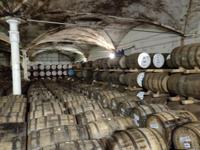Understanding esters in whisky
Contents

Esters form a group of organic compounds that are formed primarily during the fermentation process as a reaction of oxygen, acid and an alcohol with the elimination of water (a condensation reaction). Many ester compounds in alcohol result in fruity aromas.
To understand esters take as an example the tasting notes for two whiskies
- Note one - Tropical fruits like pineapple, papaya and banana, with a hint of coconut and a little glue
- Note two Fruity, with dark, ripe fruits like blackberries, plums, cherries and raisins pickled in rum, accompanied by cinnamon and star anise
These distinctly different tasting notes are based on whiskies created using the exact same ingredients - water, barley and yeast. Yet these fruity properties are more the rule than the exception, because many whiskeys have a more or less pronounced fruitiness. Fruity notes are among the easiest smells and most recognised flavours used to describing a whiskey in a sensory way. Their source, the humble ester one of the congeners
The chemistry of whisky
There are many chemical compounds made up of two different components. If, for example, an acid such as the acetic acid contained in vinegar reacts with an alcohol such as the drinking alcohol ethanol under acidic conditions, a new class of substances is created esters. This equilibrium reaction, in which water is split off, was first described by the German chemist Emil Fischer at the end of the 19th century and is therefore also known as “Fischer esterification”. Figuratively speaking, an ester behaves like a two-component ester. Glue: Acid (component 1) and alcohol (component 2) mix and - after they have displaced water from the mixture of two - stick together as esters. The esters are mainly formed during fermentation with yeast, nearly 100 different esters can be identified.
Longer fermentation times usually lead to more fruity properties in the resultant whiskey. In addition, esters are formed in the copper pot stills during distillation when different acids and alcohols, themselves by-products of fermentation, come into contact with the hot copper surface in the steam and react with one another. Rising temperatures favuor the Fischer equilibrium reaction in the direction of the products, i.e. the esters. In addition, esters are created during the years of maturation in oak barrels. Since esters are largely responsible for the pleasant and attractive fruit aromas, they are the stars in the whiskey world. Naturally, the ethyl acetate formed from acetic acid and ethanol (also known as ethyl acetate) is the most frequently found ester in whiskey. Ethyl acetate is an indicator of maturation, as it is continuously formed in the barrel and its concentration increases steadily as a result. While small amounts of ethyl acetate spread a fruity aroma reminiscent of green apples, with increasing age of the matured whiskey the amounts of this ester can reach a concentration range at which an unpleasant, chemical adhesive odor develops.
It is amazing how different the properties of the starting material (acid and alcohol) and product (ester) are. We all know formic acid - a colorless, caustic and water-soluble liquid that is often used in nature by small living things for defense purposes. If you react this corrosive chemical with ethanol, the result is formic acid ethyl ester: an ester with a distinctive aroma of rum. Some of us may remember pranks in school when a few drops of a colorless, slightly oily liquid, sprayed around the gym, caused PE classes to be canceled for a while: butyric acid. Anyone who has smelled this chemical substance will never forget it: a penetrating smell of sour milk, sweat, rancid butter and fresh vomit. It’s hard to believe what happens when this disgusting liquid reacts with ethanol. Then ethyl butyrate or ethyl butyrate is formed, a compound with a characteristic pineapple aroma! This can be continued at will, because depending on the acid and alcohol components, esters with different fruity aromas are created.
So the next time you have a malt whiskey in your glass that smells as beguiling as the air in an orchard on a hot summer day, then please also think of the fascinating chemical compounds, the esters, which are mainly responsible for this intoxicating experience.
Previous
Next

